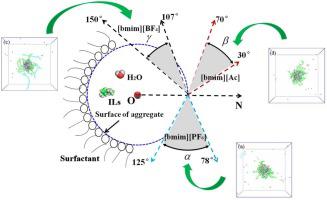当前位置:
X-MOL 学术
›
Colloids Surf. A Physicochem. Eng. Aspects
›
论文详情
Our official English website, www.x-mol.net, welcomes your feedback! (Note: you will need to create a separate account there.)
Molecular dynamics study on microstructure of supercritical CO2 microemulsions containing ionic liquids
Colloids and Surfaces A: Physicochemical and Engineering Aspects ( IF 5.2 ) Pub Date : 2020-10-01 , DOI: 10.1016/j.colsurfa.2020.125272 Hongyue Zhu , Ying Li , Dan Zhou , Qinqin Xu , Jianzhong Yin
Colloids and Surfaces A: Physicochemical and Engineering Aspects ( IF 5.2 ) Pub Date : 2020-10-01 , DOI: 10.1016/j.colsurfa.2020.125272 Hongyue Zhu , Ying Li , Dan Zhou , Qinqin Xu , Jianzhong Yin

|
Abstract Supercritical CO2 microemulsions containing ionic liquid have been widely used in materials preparation, wastewater treatment, biological medicine, and other fields due to its polar microenvironment successfully constructed in the non-polar environment. The focus of this research is to study the microstructure and thermodynamic properties of the microemulsion system through molecular dynamics simulation, with the aim of further expanding its application. Therefore, it is essential to study microstructure at first. In this paper, molecular dynamics simulations were performed to investigate the thermodynamic properties of supercritical CO2 microemulsions containing three different ionic liquids ([bmim][PF6], [bmim][BF4], and [bmim][Ac]) and surfactant Ls-mn (dodecyl polyoxyethylene (m) polyoxypropylene (n) ether) in the presence or absence of water. The simulation results identified the necessary condition for preparing scCO2 microemulsion containing ILs as presence of water. For the quaternary system, the fixed ILs content and surfactant concentration had the optimal water content value. Moreover, in the core area, except for the ionic liquid domain, part of the water was also dissolved. Simultaneously, the stretching angle of the surfactant tail chain and the radius of each system were significantly different. Ultimately, the comparative analysis of scCO2/H2O/ILs microemulsion systems based on Ls-mn hydrocarbon surfactants was conducted, and the system aggregation change law of the m/n ratio was proposed. When the m/n ratio of surfactants is smaller, that is, the hydrophilic EO groups are the less, the faster the aggregation rate of surfactants is, the higher the aggregation efficiency is, but the less the amount of water captured by clusters will be. The Ls-36 system used only 12 ns to complete the aggregation process, and the system could achieve 100 % aggregation efficiency within 150 ns. However, this system had the least amount of captured water, only 93.75 %.
中文翻译:

含离子液体的超临界CO2微乳液微观结构的分子动力学研究
摘要 含有离子液体的超临界CO2微乳液因其在非极性环境中成功构建的极性微环境而被广泛应用于材料制备、废水处理、生物医药等领域。本研究的重点是通过分子动力学模拟研究微乳液体系的微观结构和热力学性质,以进一步扩大其应用。因此,首先要研究微观结构。在本文中,通过分子动力学模拟研究了含有三种不同离子液体([bmim][PF6]、[bmim][BF4]、[bmim][Ac]) 和表面活性剂 Ls-mn (十二烷基聚氧乙烯 (m) 聚氧丙烯 (n) 醚) 在水存在或不存在下。模拟结果确定了制备含有 ILs 的 scCO2 微乳液的必要条件是水的存在。对于四元体系,固定ILs含量和表面活性剂浓度具有最佳含水量值。而且,在核心区,除了离子液体域,部分水也溶解了。同时,表面活性剂尾链的拉伸角度和各体系的半径存在显着差异。最后,对基于Ls-mn烃类表面活性剂的scCO2/H2O/ILs微乳液体系进行了对比分析,提出了m/n比的体系聚集变化规律。当表面活性剂的 m/n 比较小时,即 亲水性EO基团越少,表面活性剂的聚集速度越快,聚集效率越高,但被簇捕获的水量越少。Ls-36系统只用了12 ns就完成了聚合过程,系统在150 ns内就可以达到100%的聚合效率。然而,该系统捕获的水量最少,仅为 93.75%。
更新日期:2020-10-01
中文翻译:

含离子液体的超临界CO2微乳液微观结构的分子动力学研究
摘要 含有离子液体的超临界CO2微乳液因其在非极性环境中成功构建的极性微环境而被广泛应用于材料制备、废水处理、生物医药等领域。本研究的重点是通过分子动力学模拟研究微乳液体系的微观结构和热力学性质,以进一步扩大其应用。因此,首先要研究微观结构。在本文中,通过分子动力学模拟研究了含有三种不同离子液体([bmim][PF6]、[bmim][BF4]、[bmim][Ac]) 和表面活性剂 Ls-mn (十二烷基聚氧乙烯 (m) 聚氧丙烯 (n) 醚) 在水存在或不存在下。模拟结果确定了制备含有 ILs 的 scCO2 微乳液的必要条件是水的存在。对于四元体系,固定ILs含量和表面活性剂浓度具有最佳含水量值。而且,在核心区,除了离子液体域,部分水也溶解了。同时,表面活性剂尾链的拉伸角度和各体系的半径存在显着差异。最后,对基于Ls-mn烃类表面活性剂的scCO2/H2O/ILs微乳液体系进行了对比分析,提出了m/n比的体系聚集变化规律。当表面活性剂的 m/n 比较小时,即 亲水性EO基团越少,表面活性剂的聚集速度越快,聚集效率越高,但被簇捕获的水量越少。Ls-36系统只用了12 ns就完成了聚合过程,系统在150 ns内就可以达到100%的聚合效率。然而,该系统捕获的水量最少,仅为 93.75%。



























 京公网安备 11010802027423号
京公网安备 11010802027423号